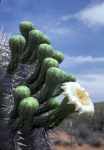This release can be found in the USGS Newsroom at: http://www.usgs.gov/newsroom/article.asp?ID=2151.
 

News Release | |||||||||||
|
Taking the Pulse of our Planet: Volunteers Needed to Track Seasonal Signs of Climate Change
See Related Podcast, "Help Us Keep an Eye on Climate Change," at http://www.usgs.gov/corecast/
Volunteers across the nation are being recruited to get outdoors and help track the effects of climate on seasonal changes in plant and animal behavior.
The USA-National Phenology Network (USA-NPN), a consortium of government, academic and citizen-scientists, is launching a new national program built on volunteer observations of flowering, fruiting and other seasonal events. Scientists and resource managers will use these observations to track effects of climate change on the Earth's life-support systems.
"This program is designed for
people interested in participating in climate change science, not just
reading about it," said USA-NPN Executive Director and U.S. Geological
Survey scientist Jake Weltzin. "We encourage everyone to visit the
USA
National Phenology Network Web site
and then go outside and observe the marvelous cycles of plant and animal
life."
Phenology is the study of the seasonal cycles of plant and animals, such
as plants sprouting, flowering and fruiting, and animals reproducing, migrating
and hibernating. Changes in these patterns, caused by climate change or
other factors, can significantly affect human economies and health. In
some areas, such changes have already imperiled species, such as in the
disappearance of some wildflowers from near Walden Pond, home of the famed
19th-century naturalist Henry David Thoreau.
The USA-NPN monitoring program harnesses the power of people and the Internet
to vastly increase the data available to scientists and the public alike,
Weltzin said. The program provides easy-to-use methods to track the life
cycles of nearly 200 species of plants, and will begin monitoring animals
next year.
Mark D. Schwartz, a professor at the University of Wisconsin-Milwaukee and chair of the USA-NPN board of directors, said monitoring changes in seasonal events across large areas helps researchers forecast the effects of global climate change on plants, animals, and ecosystems.
Among other uses, data collected by USA-NPN will help resource managers predict wildfires and pollen production, detect and control invasive species, monitor droughts, and assess the vulnerability of various plant and animal species to climate change.
The USA-NPN, based at The University of Arizona in Tucson, is built upon partnerships among citizen scientists, government agencies, nongovernment organizations, academic researchers, educators and the public. The rapidly expanding network includes collaborations among the U.S. Geological Survey, University of Wisconsin-Milwaukee, The University of Arizona, U.S. Fish and Wildlife Service, and The Wildlife Society. Project BudBurst, a major partner of the USA-NPN, is launching its second season of plant phenology monitoring.
 Arizona saguaro will be one of the species looked at by USA-NPN volunteers. Photo by Bob Szaro, USGS | |
USGS provides science for a changing world. For more information, visit www.usgs.gov.
Subscribe to USGS News Releases via our electronic mailing list or RSS feed.
**** www.usgs.gov
****
~~~~~~~~~~~~~~~~~
Catherine Puckett
USGS Office of Communications
2201 NW 40th Terrace
Gainesville, FL 32605-3574
OFFICE PHONE: 352-264-3532
CELL PHONE: 352-275-2639
FAX: 352-374-8080
EMAIL: cpuckett@xxxxxxxx
